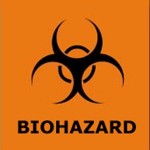A question directed to me from the CONTACT ME page of my website on January 21, 2015:
I was reading your article on infectious labeling and marking. Under marking it states that a “bulk” is (a) less than 1000 gallons or (b) greater than 1000. What about 49 CFR (Department of Transportation) §171.8 – Definitions and Abbreviations.
Bulk packaging means a packaging, other than a vessel or a barge, including a transport vehicle or freight container, in which hazardous materials are loaded with no intermediate form of containment.
A Large Packaging in which hazardous materials are loaded with an intermediate form of containment, such as one or more articles or inner packagings, is also a bulk packaging.
Additionally, a bulk packaging has: * * *
(1) A maximum capacity greater than 450 L (119 gallons) as a receptacle for a liquid;
(2) A maximum net mass greater than 400 kg (882 pounds) and a maximum capacity greater than 450 L (119 gallons) as a receptacle for a solid; or
(3) A water capacity greater than 454 kg (1000 pounds) as a receptacle for a gas as defined in §173.115 of this subchapter.
So therefore any package less than 119 gallons would be considered a non-bulk package. I personally have never seen an infectious or biohazard bulk package. It does not clearly state the information above – only stating a bulk is less than 1000 gallons.
Additionally, it is allowed to use either the DOT or the OSHA label correct?
I had an inspector recently tell me that I could not use the DOT label that the OSHA label was the only label allowed. Looking for some additional guidance.
My, as it turns out, overly optimistic reply that same day:
Thanks for the contact. I will research the topic and reply to you a little bit later today.
My final reply, a few days late (1/26/15):
Thank you for contacting me about my article: The BioHazard Marking for the Transportation of Infectious Substances. I’ll do my best to answer your questions.
- You are correct the Hazardous Materials Regulations (HMR) of the Pipeline and Hazardous Materials Safety Administration within the U.S. Department of Transportation (USDOT/PHMSa) define a bulk packaging at 49 CFR 171.8 as you indicate above.
Read more about bulk packaging
- However, your understanding of my article is not correct. In the “Package Marks” section of my article I refer to the requirements to apply a marking to different sizes of a bulk packaging. A bulk packaging with a capacity of <1,000 gal must be marked on two opposing sides; whereas a bulk packaging of ≥1,000 gal must be marked on all four sides. Both are bulk packagings as they are both >119 gallons. The 1,000 gal threshold determines where the markings are applied on the respective bulk packaging.
- My article explains that only UN3291 Regulated Medical Waste is authorized to be shipped in a bulk packaging.
- My article identifies the situations where the Infectious Substance HazMat label is required, when the OSHA-compliant BioHazard label may be used as an alternative to the Infectious Substance HazMat label, and when the OSHA-compliant BioHazard label is required to be used.
- There are two situations (identified in the “HazMat Labels” section of my article) where the DOT Infectious Substance HazMat label is required. Perhaps that is the situation the inspector was speaking to.
I hope this helps. Please don’t hesitate to contact me with any other questions.
Dan
And on January 28, 2015, another satisfied customer (well, not really a customer as they didn’t pay me. But I’m glad to help):
Thanks!
Please feel free to contact me with any questions you may have about the transportation of hazardous materials (which includes Infectious Substances) and the regulations of the USDOT/PHMSA.
 USEPA does not regulate Medical Waste. Illinois EPA does however, as a Potentially Infectious Medical Waste. USDOT regulates as an Infectious Substance when in transportation. OSHA regulates as a BioHazard when worker exposure is a concern.
USEPA does not regulate Medical Waste. Illinois EPA does however, as a Potentially Infectious Medical Waste. USDOT regulates as an Infectious Substance when in transportation. OSHA regulates as a BioHazard when worker exposure is a concern.

